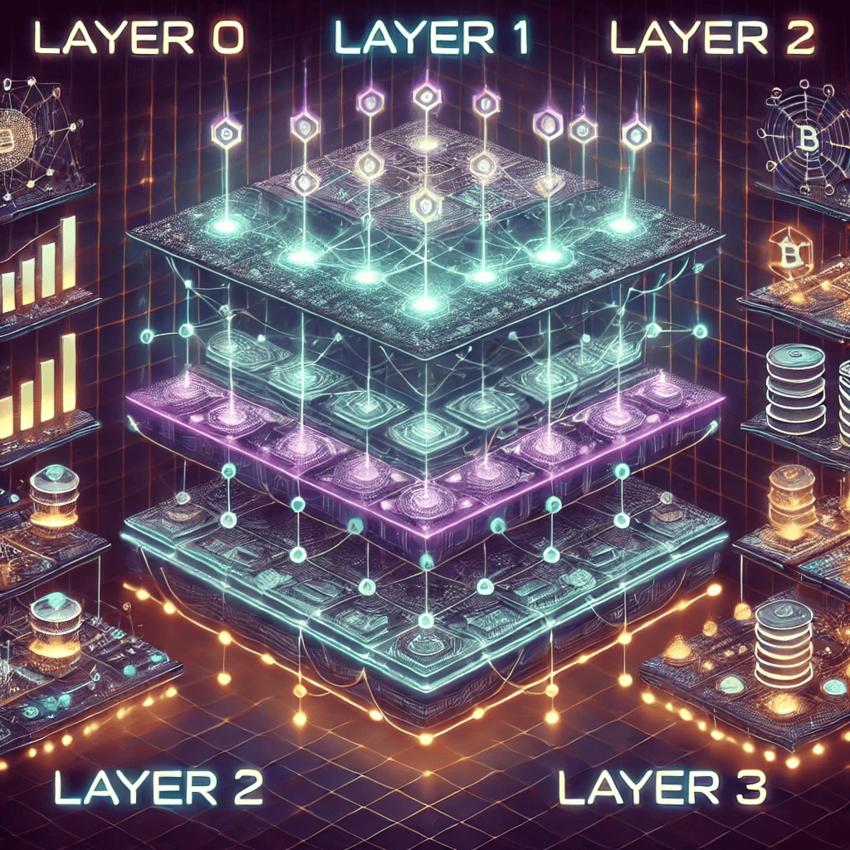Blockchain Layers: What They Are and Why They Matter

Decoding Blockchain Layers: What They Are and Why They Matter
In the cryptocurrency and blockchain space, layers refer to the architecture or protocol levels of blockchain networks. Here’s an explanation of Layer 1, Layer 2, and other potential layers:
Layer 1 (Base Layer)
Definition:
- The foundational blockchain itself, where transactions are validated and recorded.
- This layer includes the blockchain’s core protocol, consensus mechanism, and native cryptocurrency.
Examples:
- Bitcoin (BTC): Uses proof-of-work (PoW) for security and decentralization.
- Ethereum (ETH): A versatile blockchain supporting smart contracts and decentralized applications (dApps).
- Solana (SOL), Cardano (ADA), Avalanche (AVAX): Other Layer 1 blockchains with their own native protocols.
Characteristics:
- Provides security and decentralization.
- Handles all transactions directly on the main chain.
- Changes to Layer 1 require consensus from the entire network (e.g., upgrades like Ethereum’s move to proof-of-stake).
Challenges:
- Scalability: Layer 1 networks often face issues with speed and transaction costs as they grow (e.g., Ethereum’s high gas fees).
- Upgrading Layer 1 can be slow and complex.
Layer 2
Definition:
- A secondary framework or protocol built on top of a Layer 1 blockchain to improve its scalability, speed, and efficiency.
Examples:
- Lightning Network: Built on Bitcoin for fast, low-cost microtransactions.
- Polygon (MATIC): A Layer 2 solution for Ethereum, providing faster and cheaper transactions.
- Optimism and Arbitrum: Rollups for Ethereum that bundle multiple transactions into one, reducing congestion on the main chain.
Characteristics:
- Offloads some of the work from Layer 1 by processing transactions off-chain or bundling them.
- Inherits security from the underlying Layer 1 blockchain.
- Focuses on scalability, reducing transaction fees and latency.
Techniques:
- Rollups: Batch transactions off-chain and post a summary to the main chain.
- Sidechains: Independent chains connected to Layer 1 (e.g., Polygon).
- State Channels: Enable off-chain transactions for frequent exchanges between two parties.
Additional Layers in the Crypto Space
Layer 0 (Interoperability Layer)
- Definition: The foundational layer beneath Layer 1, enabling different blockchains to communicate and share data.
- Examples:
- Polkadot (DOT): Uses parachains to connect multiple blockchains.
- Cosmos (ATOM): Facilitates interoperability between blockchains using the Inter-Blockchain Communication (IBC) protocol.
- Focus: Interoperability and communication across multiple Layer 1 blockchains.
Layer 3 (Application Layer)
- Definition: The layer where decentralized applications (dApps) and protocols interact with users.
- Examples:
- Decentralized Finance (DeFi) apps like Uniswap or Aave.
- NFT platforms like OpenSea.
- Web3 applications that run on Layer 1 or Layer 2 solutions.
- Focus: User-facing functionality, including interfaces, APIs, and user experience.
Key Differences Between Layer 1 and Layer 2
Feature | Layer 1 | Layer 2 |
Definition | Base blockchain (e.g., Ethereum, Bitcoin). | Secondary solution built on top of Layer 1. |
Purpose | Security, decentralization, and validation. | Scalability, speed, and cost-efficiency. |
Transactions | Directly on the main blockchain. | Processed off-chain or batched to Layer 1. |
Security | Native to the protocol. | Relies on Layer 1’s security. |
Examples | Bitcoin, Ethereum, Solana, Cardano. | Lightning Network, Polygon, Arbitrum |
Other Emerging Concepts
Layer 4 (Ecosystem Layer):
- Focuses on integration with external systems like IoT, AI, or traditional finance (CeFi).
- Aims to bridge Web3 applications with broader industries.
Metaprotocols and Middleware:
- Protocols or services that enhance the functionality of blockchains, such as oracles (e.g., Chainlink) or indexing protocols (e.g., The Graph).
Summary
- Layer 1: The foundational blockchain (security, decentralization, core functionality).
- Layer 2: Built on top of Layer 1 to improve scalability and efficiency.
- Layer 0: Interoperability layer connecting multiple Layer 1s.
- Layer 3+: User-facing applications, ecosystems, or integrations.
Each layer addresses specific challenges and contributes to the overall growth and functionality of the blockchain ecosystem.